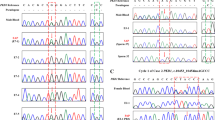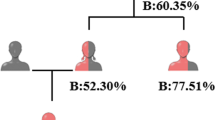Abstract
Purpose
We aim to present a case of a healthy infant born after intracytoplasmic sperm injection-in vitro fertilization (ICSI-IVF) with a preimplantation genetic diagnosis (PGD) for pantothenate kinase-associated neurodegeneration (PKAN) due to PANK2 mutation.
Methods
ICSI-IVF was performed on a Thai couple, 34-year-old female and 33-year-old male, with a family history of PKAN in their first child. Following fertilization, each of the embryos were biopsied in the cleavage stage and subsequently processed for whole-genome amplification. Genetic status of the embryos was diagnosed by linkage analysis and direct mutation testing using primer extension-based mini-sequencing. Comprehensive chromosomal aneuploidy screening was performed using a next-generation sequencing-based strategy.
Results
Only a single cycle of ICSI-IVF was processed. There were seven embryos from this couple—two were likely affected, three were likely carriers, one was likely unaffected, and one failed in target genome amplification. Aneuploidy screening was performed before making a decision on embryo transfer, and only one unaffected embryo passed the screening. That embryo was transferred in a frozen thawed cycle, and the pregnancy was successful. The diagnosis was confirmed by amniocentesis, which presented with a result consistent with PGD. At 38 weeks of gestational age, a healthy male baby was born. Postnatal genetic confirmation was also consistent with PGD and the prenatal results. At the age of 24 months, the baby presented with normal growth and development lacking any neurological symptoms.
Conclusions
We report the first successful trial of PGD for PKAN in a developing country using linkage analysis and mini-sequencing in cleavage stage embryos.


Similar content being viewed by others
References
Gregory A, Hayflick S. Neurodegeneration with brain iron accumulation disorders overview. In: Pagon RA, Adam MP, Ardinger HH, Wallace SE, Amemiya A, Bean LJH et al., eds. GeneReviews(R). Seattle (WA), 1993.
Hayflick SJ. Unraveling the Hallervorden-Spatz syndrome: pantothenate kinase-associated neurodegeneration is the name. Curr Opin Pediatr. 2003;15:572–7.
Hayflick SJ. Pantothenate kinase-associated neurodegeneration (formerly Hallervorden-Spatz syndrome). J Neurol Sci. 2003;207:106–7.
Hayflick SJ, Westaway SK, Levinson B, Zhou B, Johnson MA, Ching KH, et al. Genetic, clinical, and radiographic delineation of Hallervorden-Spatz syndrome. N Engl J Med. 2003;348:33–40.
Basille C, Frydman R, El Aly A, Hesters L, Fanchin R, Tachdjian G, et al. Preimplantation genetic diagnosis: state of the art. Eur J Obstet Gynecol Reprod Biol. 2009;145:9–13.
Thornhill AR, deDie-Smulders CE, Geraedts JP, Harper JC, Harton GL, Lavery SA, et al. ESHRE PGD Consortium ‘Best practice guidelines for clinical preimplantation genetic diagnosis (PGD) and preimplantation genetic screening (PGS)’. Hum Reprod. 2005;20:35–48.
Gutierrez-Mateo C, Sanchez-Garcia JF, Fischer J, Tormasi S, Cohen J, Munne S, et al. Preimplantation genetic diagnosis of single-gene disorders: experience with more than 200 cycles conducted by a reference laboratory in the United States. Fertil Steril. 2009;92:1544–56.
Wells D, Kaur K, Grifo J, Glassner M, Taylor JC, Fragouli E, et al. Clinical utilisation of a rapid low-pass whole genome sequencing technique for the diagnosis of aneuploidy in human embryos prior to implantation. J Med Genet. 2014;51:553–62.
Tur-Kaspa I, Jeelani R, Doraiswamy PM. Preimplantation genetic diagnosis for inherited neurological disorders. Nat Rev Neurol. 2014;10:417–24.
Chang J, Boulet SL, Jeng G, Flowers L, Kissin DM. Outcomes of in vitro fertilization with preimplantation genetic diagnosis: an analysis of the United States Assisted Reproductive Technology Surveillance Data, 2011–2012. Fertil Steril. 2016;105:394–400.
Hellani A, Abu-Amero K, Azouri J, El-Akoum S. Successful pregnancies after application of array-comparative genomic hybridization in PGS-aneuploidy screening. Reprod Biomed Online. 2008;17:841–7.
Munne S, Wells D, Cohen J. Technology requirements for preimplantation genetic diagnosis to improve assisted reproduction outcomes. Fertil Steril. 2010;94:408–30.
Heisey AS, Bell EM, Herdt-Losavio ML, Druschel C. Surveillance of congenital malformations in infants conceived through assisted reproductive technology or other fertility treatments. Birth Defects Res A Clin Mol Teratol. 2015;103:119–26.
Simpson JL. Children born after preimplantation genetic diagnosis show no increase in congenital anomalies. Hum Reprod. 2010;25:6–8.
Dahdouh EM, Balayla J, Audibert F, Genetics C, Wilson RD, Audibert F, et al. Technical update: preimplantation genetic diagnosis and screening. J Obstet Gynaecol Can. 2015;37:451–63.
Harton GL, Magli MC, Lundin K, Montag M, Lemmen J, Harper JC, et al. ESHRE PGD Consortium/Embryology Special Interest Group—best practice guidelines for polar body and embryo biopsy for preimplantation genetic diagnosis/screening (PGD/PGS). Hum Reprod. 2011;26:41–6.
Stern HJ. Preimplantation genetic diagnosis: prenatal testing for embryos finally achieving its potential. J Clin Med. 2014;3:280–309.
Hellani A, Coskun S, Tbakhi A, Al-Hassan S. Clinical application of multiple displacement amplification in preimplantation genetic diagnosis. Reprod Biomed Online. 2005;10:376–80.
Lledo B, Ten J, Galan FM, Bernabeu R. Preimplantation genetic diagnosis of Marfan syndrome using multiple displacement amplification. Fertil Steril. 2006;86:949–55.
Zimmerman RS, Jalas C, Tao X, Fedick AM, Kim JG, Pepe RJ, et al. Development and validation of concurrent preimplantation genetic diagnosis for single gene disorders and comprehensive chromosomal aneuploidy screening without whole genome amplification. Fertil Steril. 2016;105:286–94.
Smith WM, Van Orsouw NJ, Fox EA, Kolodner RD, Vijg J, Eng C. Accurate, high-throughput “snapshot” detection of hMLH1 mutations by two-dimensional DNA electrophoresis. Genet Test. 1998;2:43–53.
Harton GL, De Rycke M, Fiorentino F, Moutou C, SenGupta S, Traeger-Synodinos J, et al. ESHRE PGD consortium best practice guidelines for amplification-based PGD. Hum Reprod. 2011;26:33–40.
Piyamongkol W, Vutyavanich T, Piyamongkol S, Wells D, Kunaviktikul C, Tongsong T, et al. A successful strategy for preimplantation genetic diagnosis of beta-thalassemia and simultaneous detection of Down’s syndrome using multiplex fluorescent PCR. J Med Assoc Thai. 2006;89:918–27.
Piyamongkol W, Vutyavanich T, Sanguansermsri T. Preimplantation genetic diagnosis of alpha-thalassemia-SEA using novel multiplex fluorescent PCR. J Assist Reprod Genet. 2012;29:95–102.
Schenker JG. Assisted reproductive practice: religious perspectives. Reprod Biomed Online. 2005;10:310–9.
Acknowledgments
This work is a part of the project entitled “Stem cell-based technology as research models for genetic disorders; diagnostic strategies, treatment discovery and disease prevention” (S. Hongeng as the principal investigator). The research was supported in grants to the sub-project “Search the molecular basis of rare genetic disorders as a model for disease prevention using preimplantation blastocyst technology” (to O. Trachoo) and “Preimplantation genetic diagnosis for rare genetic disorders” (to W. Choktanasiri) by Mahidol University and the National Research Council of Thailand. The grants for next-generation sequencing were partially supported by the Center for Medical Genomics in collaboration between the Faculty of Medicine, Ramathibodi Hospital, Mahidol University, and the Thailand Center of Excellence for Life Science (TCELS), Ministry of Science, Thailand (to W. Chantratita). We are grateful to the couple for their excellent participation in the project; to Dr. K. Sakpichaisakul, Maharat Nakhon Ratchasima Hospital, Thailand, for nice clinical data collection and referral; to B. Matthayomchan and P. Srikittayakorn, Thai Reproductive Genetic Laboratory for technical assistance in embryo biopsy; to the people in the Center for Medical Genomics and Stem Cell Research Cluster, Faculty of Medicine Ramathibodi Hospital, Mahidol University, Thailand, for their kind comments during project progression; and to Professor P. Sritara, Dean of Faculty of Medicine Ramathibodi Hospital, for support and encouragement.
Author information
Authors and Affiliations
Corresponding author
Ethics declarations
Conflict of interest
The authors declare that they have no conflicts of interest.
Additional information
Capsule
Pantothenate kinase-associated neurodegeneration is a life-threatening and incurable autosomal recessive disorder characterized by progressive extrapyramidal dysfunction. Here we present the first successful trial to utilize preimplantation genetic diagnosis technology for a couple who had an experience on the loss of their first child affected by this particular inherited neurological condition.
Rights and permissions
About this article
Cite this article
Trachoo, O., Satirapod, C., Panthan, B. et al. First successful trial of preimplantation genetic diagnosis for pantothenate kinase-associated neurodegeneration. J Assist Reprod Genet 34, 109–116 (2017). https://doi.org/10.1007/s10815-016-0833-y
Received:
Accepted:
Published:
Issue Date:
DOI: https://doi.org/10.1007/s10815-016-0833-y




